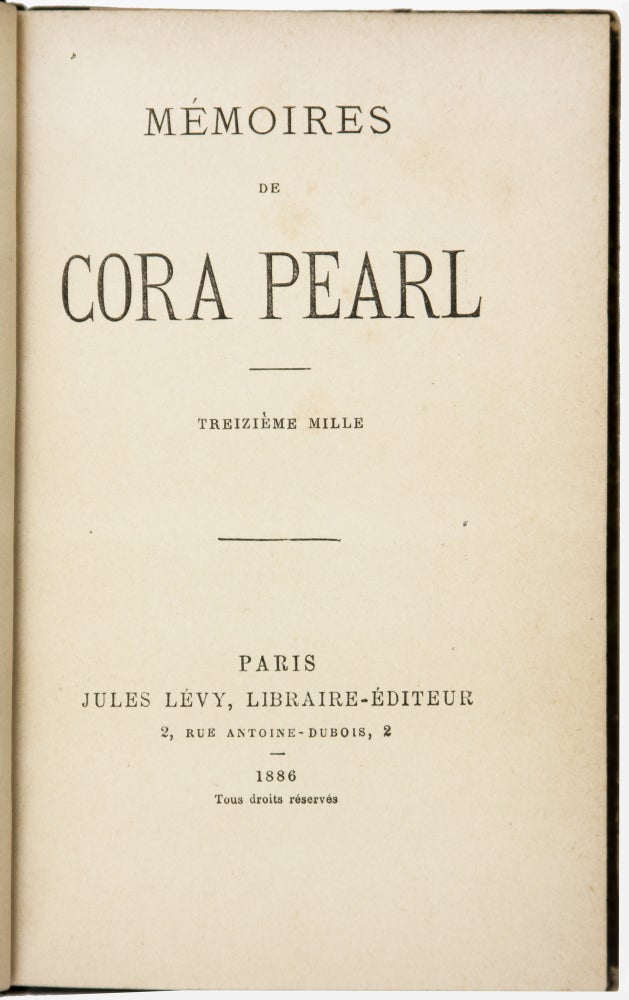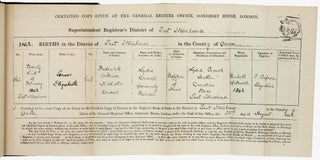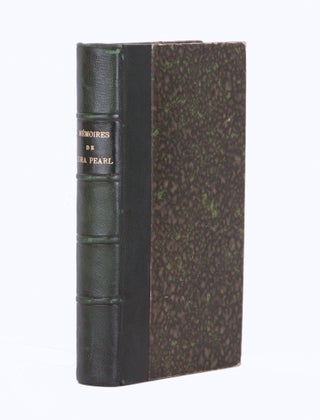Mémoires de Cora Pearl.
18mo (18 x 11.5 cm), (2) ff, 360 pp. Complete with 1 folding facsimile plate of Cora Pearl's birth certificate. Quarter-bound in green calf, marbled paper boards, marbled pastedowns and endpapers, raised bands. Very light toning, fine internally. The first edition (a later issue) of the memoirs of the renowned French courtesan Cora Pearl (1835-1886), published the year of her death. Before the publication, she is said to have contacted her former lovers, offering to anonymize their names in her autobiography if they paid her. Greatly successful, the book ran several editions and was subsequently published in London. Among Cora Pearl's lovers were the Prince of Orange (the heir to the throne of the Netherlands); Prince Achille Murat; Victor Massena (the grandson of Napoleon's great marshal), third Duc de Rivoli and later fifth Prince of Essling; and Emperor's cousin Joseph Charles Paul Bonaparte. The memoirs are chuck-full of witty remarks and stories of a woman, who led one of the most fascinating lives in nineteenth-century Paris. Born in Plymouth, England about 1835 as Eliza Emma Crouch, in her early twenties she was raped by a middle-aged diamond merchant--an experience that left her horrified of all men for the rest of her life, as she writes in her Memoires. After the horrific encounter she rented a room near Covent Garden and soon became the mistress of Robert Bignell, the proprietor of the Argyll Rooms, a notorious London men's club. Upon their visit to Paris, she became enamored with the city and chose to remain there under the pseudonym of "Cora Pearl," where "by unanimous consent she became, for twenty-five years, the prototype of the modern courtesan" (Richardson, p. 28). "From 1852, Cora Pearl set the tone for that world of gallantry whose eccentricities always ended leaving their mark on the real world. People who went to the Bois were determined to have a carriage modelled on hers, with little cafe-au-lait coloured horses, as like as possible to the ones that she drove herself. It went without saying that the women of Paris, beginning with those at Court, copied her clothes, her hair, her habits, and soon her fantastic behaviours... Perhaps, her piquancy, her exotic accent, her toughness, her independence, even her outrageous behavior proved as seductive as her perfect figure. She found it easy to seduce the husbands and lovers of the most beautiful women in Paris" (Richardson, p. 28). Cora Pearl's demise was brought upon by Alexandre Duval--a man ten years her junior. They became involved when she was thirty-seven years old. When Duval reached the end of his financial resources and Cora dismissed him, he came to her house with a revolver, with which he meant to shoot Cora. The revolver went off, wounding him greatly. In the end he survived, but the scandal had been so great, that Cora was asked to leave France. After the incident, her fame quickly waned. She died four months after her Mémoires had been published. The edition appears to be rare on the market. *Richardson, The courtesans: the demi-monde in 19th century France (2000), esp. pp. 25-39; Authier, Femmes d'exception, femmes d'influence: Une histoire des courtisanes au XIXe siècle (2015), pp. 228-229.
Price: $1,750.00



